Where the Catholic Sun Doth Shine...
 (with thanks to www.dominikaner-wien.at)
(with thanks to www.dominikaner-wien.at) The Blog of an English Catholic Priest
 (with thanks to www.dominikaner-wien.at)
(with thanks to www.dominikaner-wien.at) 
Just back from my brief visit to the Catholic Record Society Conference at Liverpool Hope University. Before catching my train I had a very enjoyable lunch with the Prior of Downside and a simply professed Knight of Malta.
The highlight of the conference (so far) was a talk by Dr Peter Leech about the Roman Catholic Chapel of King James II at Whitehall (1686-88). During the brief years of his reign, James had a separate Roman Catholic establishment at Court. At Midnight Mass 1686 the King’s new Catholic Chapel was officially opened at Whitehall. Designed by Christopher Wren, with interior carvings in stone and wood by Grinling Gibbons and paintings by Benedetto Gennari and Antonio Verrio, it was one of the most lavish ecclesiastical buildings in England to be built after the Reformation. The maestro di cappella was the Italian composer Innocentio Fede (born circa 1661) from a famous musical family who dominated music in Rome in the last quarter of the seventeenth century.
Sadly the chapel was destroyed in the great Whitehall fire during the reign of Queen Anne, but much of its contents have survived – the organ case is in St James’, Piccadilly, some of the sculpted angels are in the church at Burnham-on-Sea (Somerset) and Gennari’s Annunciation altarpiece is at the Ringling Museum of Art, Florida.
The Conference numbered about 60 people. I was asked to be principal celebrant at the Mass this morning in the University Chapel. In looking for the sacristy, I accidentally stumbled into the Muslim prayer room! The Mass had two ‘firsts’ for me – the first (and last) time I’ve celebrated the holy mysteries with a pebble arrangement on the altar and the first time I’ve been the principal celebrant with a bishop concelebrating (not theologically ideal, I know, but I did ask the bishop whether he wanted to be chief celebrant instead).
PS I also popped into the famous R.C. Metropolitan Cathedral (above) - not my style but there is, at least, a prayerful atmosphere inside (unlike the Anglican one down the road).

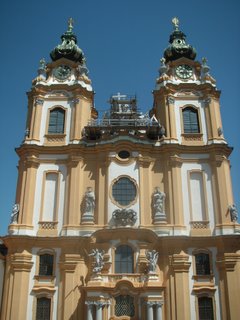

Rather amazingly this obscure Celt was the patron saint of Austria before his contemporary, St Leopold, replaced him in 1663. We know nothing about Coloman’s early life, except that he came from Ireland (or possibly Scotland). Later tradition identifies him as a King's son and he is often shown in pilgrim's garb, with a crown at his feet.
Around 1012 the saint embarked on a pilgrimage to Jerusalem, as many did at the time despite the perils of travel and the unstable situation in the Middle East. Unfortunately, the region around Vienna was also volatile, with ongoing conflict between the Austrians, Bohemians and Moravians. St Coloman, with his strange language and clothing, was captured at Stockerau on suspicion of being a spy. Unable to defend himself owing to the barrier of language, he was hanged from a tree on 13th July 1012.
Perhaps the people of Stockerau found out his real identity and began to feel guilty for a cult of ‘Coloman the Martyr’ soon emerged and miracles were claimed. When, on 13th October 1014, his body was moved to Melk, it was found to be incorrupt. His remains still rest there, now ornamented by a Baroque altarpiece, with the saint kneeling at the foot of a rather striking obelisk ascending towards Heaven.

Many churches are dedicated to him in German speaking lands, including this famous pilgrimage church (Wallsfahrtskirche St Coloman) in Schwangau, Bavaria, not far from Mad King Ludwig's Schloss Neuschwanstein. It is believed that St Coloman passed through the area on his way to the Holy Land and that he rested, preached and/or even pastured cattle here. This perhaps explains the colourful celebrations on the Sunday nearest to his feast (13th October), the Colomansfest. The little church is surrounded by several hundred horses and decorated carriages. After Mass, the devotees of the Irish pilgrim ride around the church three times to receive his blessing - followed by a feast of beer and meat. Here's a picture I took of the church through a coach window back in February.
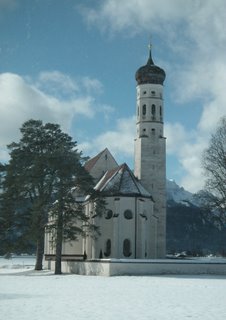
The Melk website draws out the contemporary relevance of the saint: 'in our times, where listening to each other has become increasingly difficult, he can be seen as a contemporary saint, as he, stranger in a strange land, was not understood. Whoever is different, looks or speaks differently, makes himself suspicious, causes fear, and can easily become the victim of prejudice.'
Labels: Saints



Labels: Saints
 Hopefully you can just make out the two 'themes' of this side altar at the Peterskirche in Vienna (run by Opus Dei). Below the mensa is the reposing skeleton of a Roman catacomb martyr, St Donatus. Above is a small painting of St Josemaria Escriva. There is something for everyone in the Communion of Saints!
Hopefully you can just make out the two 'themes' of this side altar at the Peterskirche in Vienna (run by Opus Dei). Below the mensa is the reposing skeleton of a Roman catacomb martyr, St Donatus. Above is a small painting of St Josemaria Escriva. There is something for everyone in the Communion of Saints!
 The state of the Catholic Church in Austria reminds me a bit of the Church of England. It is the custodian of an impressive historical and cultural patrimony but, as an institution, it is suffering from alarming decline. About 17% of Austrian Catholics are ‘Mass-goers,’ though Vienna is statistically the most ‘secular’ part of the country.
The state of the Catholic Church in Austria reminds me a bit of the Church of England. It is the custodian of an impressive historical and cultural patrimony but, as an institution, it is suffering from alarming decline. About 17% of Austrian Catholics are ‘Mass-goers,’ though Vienna is statistically the most ‘secular’ part of the country.
Labels: Blogging
 Just to leave the Austrian theme for a moment, I thought I should 'share' these amazing photos of a Requiem held in Rome a few months ago for the Principessa Eliane Radziwill. Hat tip to a new blogger, Fred Fornello over at Cantate Domino - a Roman blog full of fun pictures. Most amazing is the picture of the Princess's gloves, which lay crossed on the catafalque (useful to know in case I ever have to celebrate a Requiem for a Princess!).
Just to leave the Austrian theme for a moment, I thought I should 'share' these amazing photos of a Requiem held in Rome a few months ago for the Principessa Eliane Radziwill. Hat tip to a new blogger, Fred Fornello over at Cantate Domino - a Roman blog full of fun pictures. Most amazing is the picture of the Princess's gloves, which lay crossed on the catafalque (useful to know in case I ever have to celebrate a Requiem for a Princess!).
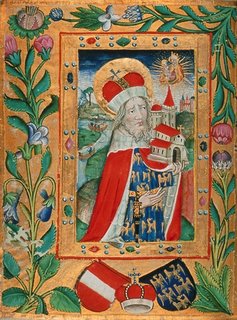
Over the next few days and weeks I will gradually post various Austrian pictures and items - and I think a good place to start is the charming legend of St Leopold, one of the patrons of Austria and the founder of Klosterneuburg.
St Leopold III 'the Good' (1073-1136) was a member of the Babenburg dynasty (the dominant ruling house in Austria before the Habsburgs) and, from 1095, the Margrave of Austria. As well as consolidating Babenburg power and promoting peace, St Leopold is chiefly remembered as a founder of monasteries - Heiligenkreuz, Kleinmarazell, Seitenstetten and (most importantly) Klosterneuburg, which became his residence and (eventually) his final resting place. In fact my guest bedroom was almost directly above the chapel where his relics are kept, so I developed quite a devotion to him during my stay!

The legend of the founding of Klosterneuburg is a particularly charming one. St Leopold married Agnes, an influential lady in her own right as the widow of Frederick I of Swabia and the mother of Conrad, the future King of Germany (she was thus the mother of the Staufer dynasty). On the day of the wedding, a gust of wind blew her veil from her head as the happy couple were standing on a balcony of their hilltop castle at Leopoldsburg. A careful search was unable to retrieve it but Leopold made a vow that if he found the veil he would thank the Lord by building a church on the spot.

Nine years later (in 1114) he found the veil in an elderberry tree while on a hunting expedition. As can be seen in the painting above, Our Lady appeared and ordered the building of what would become Stift Klosterneuburg.
The Schleierlegende ('Legend of the Veil') is picturesque but full of historical inaccuracies - at the time of the wedding there was no castle on the Leopoldsburg and there was already a settlement at Klosterneuburg (in fact, there has been a human presence here since the Stone Age). The legend is only first mentioned in written form in 1371 and has since been much celebrated in art. But that's not to say that we should disregard the legend. The essential truth is that Klosterneuburg owes its foundation to Leopold and Agnes - and, given it is the story of a noblewoman's veil, perhaps Agnes played a central role.
The veil and parts of the elderberry bush are still kept in the Stift's Schatzkammer (Treasury) - the latter formerly being kept in the centre of the magnificent branched candlestick, donated to the Stift by its founders (below).

Ever since St Leopold's canonisation in 1485, his feast (15th November) has been a red letter day at Klosterneuburg, when his relics are displayed for public veneration (you can see his skull, dressed in the archdukal crown, in the picture below). Devotees traditionally slide down the side of a giant wine barrel (Binderstadel) that is kept in the monastery cellar and holds 56,000 litres - the ceremony is called Fasselrutschen. 'Where the Catholic sun doth shine there is laughter and good red wine.'



Labels: Saints

Yes, it's time for my long-awaited holidays and on Monday morning I fly to Vienna with Fr Richard Whinder to spend a week at Klosterneuburg, the 'Austrian Escorial.' Expect lots of posts when I get back - but, sorry, I'm not the king of blogger who spends his holiday hunting out internet cafes!
Thanks for your support over the past few months - Roman Miscellany has now received over 5,000 visitors and on one day this last week (Tuesday) there were, for some obscure reason, 250 hits!
See you soon and God bless.
Your Famous Last Words Will Be: |
 "What we know is not much. What we don't know is enormous." |
Labels: Humour
Labels: Parish
 Today is the optional memoria of St Henry (972 - 1024) - a saint I'll definitely be celebrating at the 7pm Mass because 'Henry' was one of my Confirmation names (the other was 'Richard').
Today is the optional memoria of St Henry (972 - 1024) - a saint I'll definitely be celebrating at the 7pm Mass because 'Henry' was one of my Confirmation names (the other was 'Richard').
St Henry succeeded his father as Duke of Bavaria in 995 and was elected Holy Roman Emperor in 1002. His cult developed along the same lines as that of St Edward the Confessor - St Henry is remembered as a just ruler, a defender of the Church, a friend of the poor and a model of virtue (indeed, he and his Queen, St Cunegund, are said to have vowed themselves to perpetual chastity). He considered abdicating and becoming a monk after Cunegund's death but the Abbot of Verdun persuaded him to persevere in his imperial vocation.
He died on 13 July 1024 and was canonised in 1146 - he is buried in Bamberg Cathedral (a See which he founded in 1007):

Labels: Saints



Labels: Papal
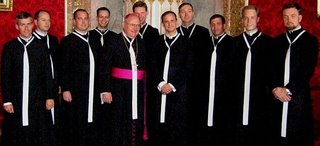
This happy group shows members of Stift Klosterneuburg [Stift means an ancient monastic 'endowment' or 'foundation'], with their Provost in the centre (who has the privilege of dressing as a bishop). The most striking element of the habit is the long white ribbon, which is called a sarozium. The word derives from sacrum rochettum (sacred rochet), a garment today reserved for prelates and some chapters of canons, which in its full form resembles a long surplice with tight-fitting sleeves. Here is Thomas à Kempis (of the Congregation of Windesheim) wearing his rochet:

The solemnly professed Canons Regular of Stift Klosterneuburg wear full rochets at liturgical functions:

The canons originally wore the rochet all the time. At one stage in its development, the rochet looked a bit like an apron, as seen in this portrait of Andreas Mosmiles, a seventeenth century Provost of Stift Klosterneuburg: Or this unusual picture of St Anthony of Padua, who before joining the Franciscans was a Canon Regular of the Holy Cross of Coimbra:
Or this unusual picture of St Anthony of Padua, who before joining the Franciscans was a Canon Regular of the Holy Cross of Coimbra:
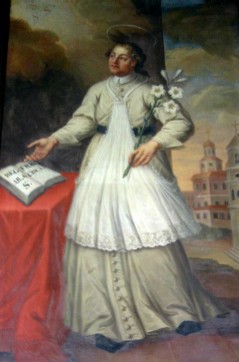
For practical reasons the rochet was reduced to the sarozium (and the cassock, originally white, became black), as demonstrated by this handy picture:
The sarozium is a reminder that the canon is dedicated to the service of God not only when he is in choir but wherever he is. Here is the Freench spiritual master, Raymond Jordan (d.1400), showing off his sarozium in a much later painting.
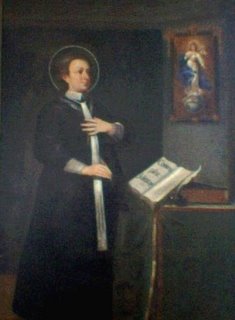
On solemnities the canons at Klosterneuburg wear a violet mozzetta over the rochet:
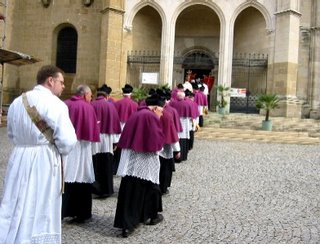 Previously they wore a fur cape with tassels called an almutium. This can often be seen in paintings of the Czech martyr, St John Nepomuk, who was thrown off a bridge for not divulging the secrets of the Confessional - see, for example, this lovely painting by Szymon Czechowicz:
Previously they wore a fur cape with tassels called an almutium. This can often be seen in paintings of the Czech martyr, St John Nepomuk, who was thrown off a bridge for not divulging the secrets of the Confessional - see, for example, this lovely painting by Szymon Czechowicz:

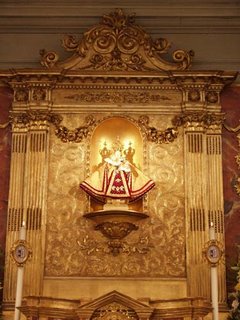



I think all churches should have an accessory like this. It actually reminds me of Inspector Gadget!



Labels: Papal
Labels: Papal
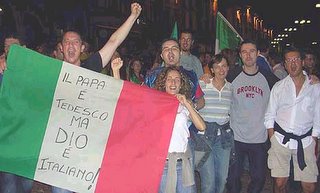
Labels: Papal